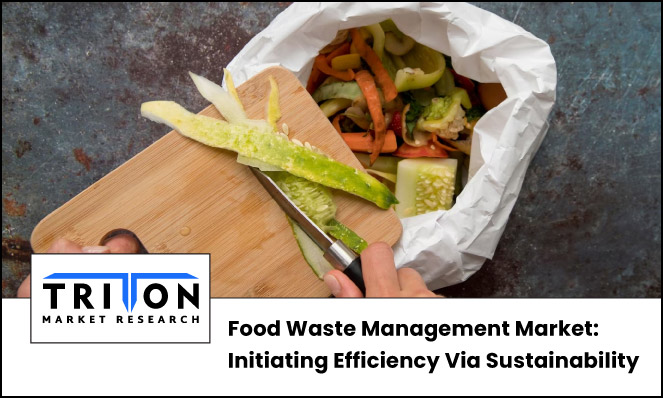



12, June 2023

Over the years, the share of global food wastage has risen significantly, having a detrimental effect on the economy and the environment. As per the Food and Agriculture Organization, nearly one-third of the food gets wasted annually, accounting for around 1.3 billion tons. Moreover, the UN Food Waste Index Report 2021 reported that approximately 17% of the food is wasted at the retail and consumer levels. This food loss indicates the depletion of natural resources, necessitating the development of waste management systems to enhance food security and sustainability. Triton’s analysis suggests that the global food waste management market is estimated to expand with a CAGR of 5.66% from 2023 to 2030.
Additionally, the market is expected to garner revenue worth $63.31 billion by 2030. Governments globally are acknowledging the importance of food waste management solutions. For instance, in February 2023, the US Department of Agriculture (USDA) invested more than $9.4 million in 45 compost and food waste reduction projects that support scalable waste management plans to decrease and deflect food waste from landfills.
Global food depletion has paved the path for innovative solutions, from organic feed production to technology-driven waste management. Let’s take a deeper look into these major trends.
One of the key sustainable solutions to reduce food wastage in landfills is its use in animal feed production, particularly livestock. This waste management solution simultaneously helps address issues like food security, resource conservation, pollution, and climate change. As per Triton’s analysis, in terms of the recycling service segment, the animal feed category is estimated to advance with a CAGR of 6.29% over 2023-2030.
Moreover, this sustainable method contributes heavily to a circular economy, prompting various strategic initiatives. For instance, in January 2023, Nest Co-Founder Matt Rogers introduced a new service that enables consumers to turn household waste into chicken feed for $33 per month.
Further, foods such as fruits, vegetables, dairy, cereals, bread, etc., have emerged as key fertilizing agents, enhancing soil health, reducing erosion, and improving water quality. Likewise, organic food waste can be used for natural gas and biofuel production, lessening reliance on fossil fuels. Given these parameters, fruits and vegetables is anticipated to emerge as the fastest-growing waste type at a CAGR of 6.02% during the forecast period 2023-2030. In addition to being a good source of micro and macronutrients, food waste eliminates various plant diseases. Hence, the increasing trend of conversion of organic food waste to animal feed and fertilizer widens the global scope of food waste management.
In the waste management sector, there has been a growing inclination among the leading players to reconsider conventional methods and adopt cutting-edge solutions. In this regard, big data has enabled organizations to accurately gain data on garbage levels, increasing operational efficiency. Further, smart waste management via AI, machine learning, and IoT improves every facet of trash management, from collection to recycling.
Accordingly, easyJet Holidays, in March 2023, introduced an AI-powered hotel food waste reduction scheme in partnership with Winnow. This scheme will enable partner hotels to leverage AI to run more sustainable kitchens.
Furthermore, according to the US Department of Agriculture, around 30-40% of the food supply is wasted, costing approximately $218 billion. Moreover, food accounts for 24% of the solid waste in landfills. This high wastage resulted in the introduction of a federal interagency strategy between USDA, EPA, and FDA to address food waste under the Winning on Reducing Food Waste Initiative. As a result, government initiatives backed by technological advancements fuel the North America food waste management market’s expansion, spearheaded by the United States.
As per United Nations, the global human population reached 8 billion in mid-November 2022. This number is expected to surge by nearly 2 billion by 2050. This will boost food consumption, simultaneously adding to food wastage levels. Additionally, the growing demand for ready-to-eat meals and flexible packaging solutions has soared retail and eCommerce food sales in recent years.
What’s more, with around 11.3% of the world’s population suffering from chronic hunger and malnutrition, effective food management has become crucial for businesses and communities. As a result, the need to create workable, sustainable solutions to escalating food waste is estimated to create opportunities for the food waste management market.
In 2022, the global food waste management market garnered $40.55 million.
Q2) Which are the major food waste types?Fruits & vegetables, processed food, cereal, and dairy products are major food waste types.

Prevalent cases of terrorist attacks in today’s world is increasing the need for severe standards of security for public safety, and the global market for biometric technology scrupulously accommoda..
Prevalent cases of terrorist attacks in today’s world is increasing the need for..